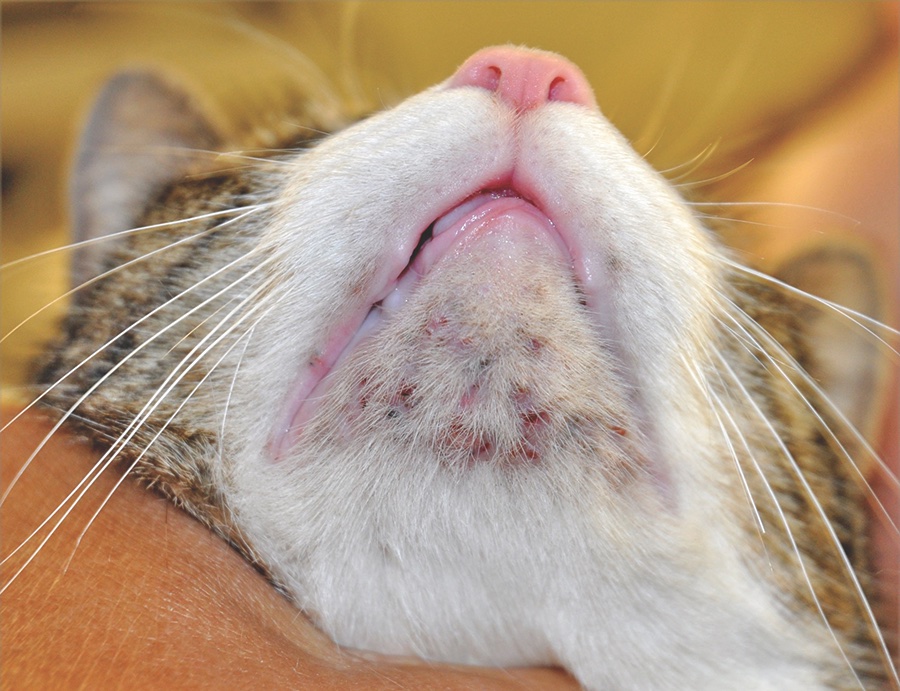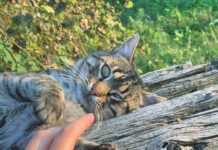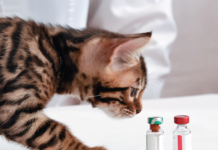What You Can Do
Use glass, ceramic, or stainless-steel dishes. Clean your cat’s chin daily if she tends to be a messy eater, particularly after eating canned food. Check her whole skin and coat for evidence of allergies, seborrhea, and parasites. Help with grooming if you notice she has problem areas.
With feline acne, the initial lesion is a tiny blackhead that may be hidden by hair. The condition is due to blocked hair follicles, mild seborrhea (scaly, inflamed skin), and faulty keratinization (protein accumulation in the skin). The hair follicles may get inflamed, and secondary bacterial infections can cause pimples and pustules.
For most cats, this is a mild problem. “The cat couldn’t care less,” says William H. Miller, Jr., VMD, DACVD, professor emeritus of medicine in the section of dermatology at Cornell University’s College of Veterinary Medicine. “My suggestion is leave it alone but monitor it to see if things get worse. Worse means the follicle gets inflamed and papules, pustules, or furuncles develop.”
What Causes Feline Acne?
Feline acne has no definitive single cause. Stress, the aftermath of a viral infection, other skin problems such as allergies, or parasites such as Demodex mites are all possible causes. Some veterinarians believe plastic dishes may contribute, as cats might be mildly allergic to some plastics, and plastic surfaces may harbor bacterial contamination.
Diagnosis
Most veterinarians diagnose feline acne based upon the appearance of the chin and sometimes the lips. Your veterinarian may take a skin swab, smear it on a slide, and look at it under a microscope to look for bacteria, or may take a culture from a pustule if these are present. If the whole chin is involved, a skin scraping for mites and a fungal culture might be in order.
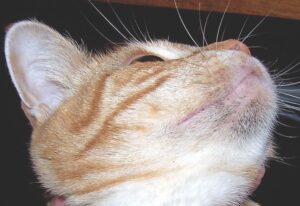
Treatment
Mild cases bother you more than your cat, and fussing over the area may irritate your cat. The best treatment for mild cases is to watch for inflammation or signs of secondary infection.
If the acne appears to be getting inflamed and/or infected, then treatment is in order. Moderate cases can often be managed topically. Gentle, warm compresses can help to soften up blackheads.
“Topicals like 60% propylene glycol in water work well. Benzoyl peroxide products are touted as being very effective, but they are also potentially very irritating and can make things worse rather than better,” says Dr. Miller. “Although topical antibiotics are commonly used to soften the blackheads, I don’t suggest them unless the follicles are inflamed or infected. With infected lesions, the topical antibiotic mupirocin is widely used and is very effective.” If mites or ringworm are detected, then specific therapy is used for those cases. Suspected allergies should be identified and treated.
Dietary omega-3 fatty acid supplementation may help to prevent recurrence and keep mild cases under control. If your cat has plastic food and water bowls, switch them to smooth, shallow ceramic or stainless-steel bowls for 60 days or so. If no improvement is noted, you can return to the old bowls. Be sure to clean your bowls daily (always a good practice for all pets).
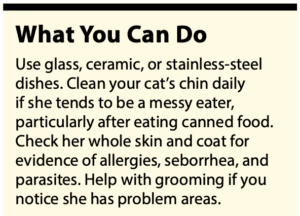 Some veterinarians believe that feline acne is partly due to poor grooming by the cat. If you see mats or other signs of poor grooming, it can help to carefully wipe the chin daily with gentle wipes such as unscented baby wipes. If the chin is infected, it may be painful.
Some veterinarians believe that feline acne is partly due to poor grooming by the cat. If you see mats or other signs of poor grooming, it can help to carefully wipe the chin daily with gentle wipes such as unscented baby wipes. If the chin is infected, it may be painful.
Severe Cases
Cats with severe lesions face more concentrated treatment. “With very large lesions, the topical may not penetrate deep into the tissue and a systemic antibiotic will be necessary,” says Dr. Miller. “In really bad cases, steroids are indicated to calm down the inflammation that is destroying the follicle and its surrounding tissue. I like to use a short course, usually five days or so, of oral steroids starting a day or two after the antibiotic is started. Because the lesions of severe acne reach deep into the tissues, the progress of treatment should be judged by the veterinarian. These lesions always heal on the surface before deep healing has occurred. If treatment is stopped when the surface has just healed, a relapse is very likely.”
Prevention is difficult since the cause is often unknown.
William H. Miller, Jr., VMD, DACVD, professor emeritus of medicine in the section of dermatology at Cornell University’s College of Veterinary Medicine

